 Technology peripherals
Technology peripherals
 AI
AI
 A brief discussion on automotive image sensor parameters - signal-to-noise ratio
A brief discussion on automotive image sensor parameters - signal-to-noise ratio
A brief discussion on automotive image sensor parameters - signal-to-noise ratio
Author | William Chen, Automotive Field Application Engineering Manager, ON Semiconductor China
Intelligent driving has gradually become a common feature of cars, which enhances the comfort of cars and drivers. Perception ability reduces the driver's work intensity and can effectively improve driving safety. Among them, the camera based on CMOS image sensor is one of the main tools for the intelligent driving system to perceive the external environment.
CMOSThe image sensor is an imaging sensor, which is essentially a memory and analog-to-digital conversion (ADC) The combination. Based on the photoelectric effect of silicon, incident light will excite charges in the photosensitive diodes of the sensor pixels. The charges are collected and stored and converted into digital output through ADC.
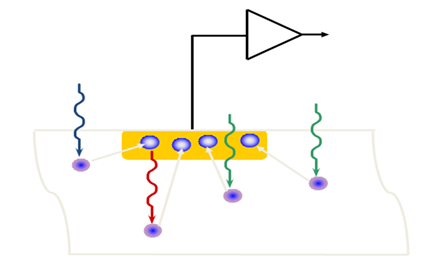
##Figure 1Photoelectric Effect
Architecturally, a CMOS image sensor is similar to a memory. It has a large number of storage cells and supports row and column addressing. Operation, the difference is that the memory is written by the circuit, while the content in the sensor is written by visible light or near-infrared light.
The charge collected by the sensor includes two parts: one part is the charge we expect, which comes from ambient light The effective signal excited; the other part is the charge generated by the interference that the user does not want. There are many sources of interference, which are generally referred to as noise.
We hope that the more effective information in the image, the better, and the less interference noise, the better. A common indicator to measure the effect of image noise is the signal-to-noise ratio SNR, which is the ratio of signal to noise. The greater the signal-to-noise ratio, the smaller the relative content of image noise and the better the image quality. The unit of SNR can be a ratio, or it can be converted into a logarithmic unit dB.


The sensor data sheet generally provides the signal-to-noise ratio parameter SNR, as shown below.

There is a common question: 46# Is the low-light effect of a sensor with ##dB signal-to-noise ratio better than that of a sensor with 43dB?
The answer is not necessarily, conclusions that are out of condition often fall into the pit.
SNR is not a point, it is a function of lighting conditions. As shown in Figure 2, SNR will become a line as the lighting intensity changes. curve. When it is used as a low-light effect indicator, it is required to select the SNR value under low-light conditions. The SNR parameter on the sensor data manual in the industry is usually the maximum SNR value, which corresponds to the SNR value when the lighting environment is very bright, that is, the SNR Max in the upper right corner of the blue SNR curve in the figure. point. The SNR value in the area where the blue line is located in the lower left corner is suitable as a parameter for evaluating low light. The illumination at this time is insufficient and corresponds to a low light environment. It's like selling apples. The top layer is the best. You need to open the basket to see the quality of the apples inside.
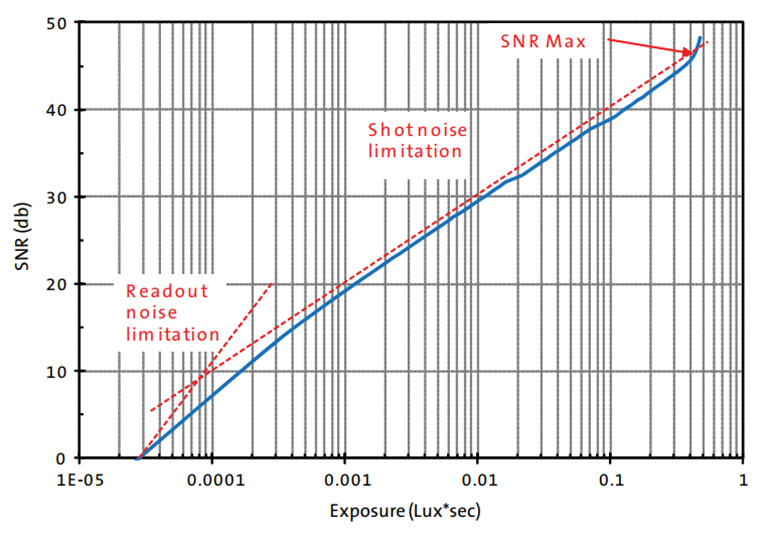 Figure
Figure
2Signal to noise ratio SNR curve
Judging the sensor based on the maximum SNR point has the problem of overgeneralization. According to needs, the user can select the SNR size corresponding to the specific exposure condition to evaluate the low-light noise. The larger the SNR, the better; the user can also limit the SNR to a fixed value, such as SNR=5, use the Exposure value of the exposure condition required at this time to judge the low-light noise. The smaller the Exposure value means that less lighting resources are needed to achieve the same SNR, and the better the low-light performance of the sensor.
Figure 2 shows the SNR of an ordinary sensor, which is a monotonically increasing curve. The CMOS sensor used in cars requires a high dynamic range HDR to match all-weather application scenarios. The common method for HDR is to change the sensitivity of the sensor and sample different brightnesses of the environment separately. Then map the multiple sampled image frames to a standardized linear data space, and finally select appropriate pixels from frames with different sensitivities to form a complete image frame. See "A Brief Discussion on Automotive Image Sensor Parameters - Dynamic Range".
The sensitivity change of the sensor corresponds to the SNR line in the coordinate system moving to different positions, and the evolution of the SNR curve of the final HDR image The fitting results of multiple SNR curves, such as the blue line in Figure 3, are no longer a monotonic increasing curve. In addition to the low-light SNR being very small, there will also be multiple local minima in the highlight interval. When working When the point falls in the SNR drop range, the noise will worsen even if the environment is very bright at this time.
This will cause a phenomenon that goes against the perception of the human eye in the image, that is, as the brightness increases , the image quality will go from bad to good, and then suddenly deteriorate again. Therefore, unlike traditional linear sensors, the signal-to-noise ratio of automotive wide dynamic sensors also needs to evaluate the minimum value index under bright conditions.
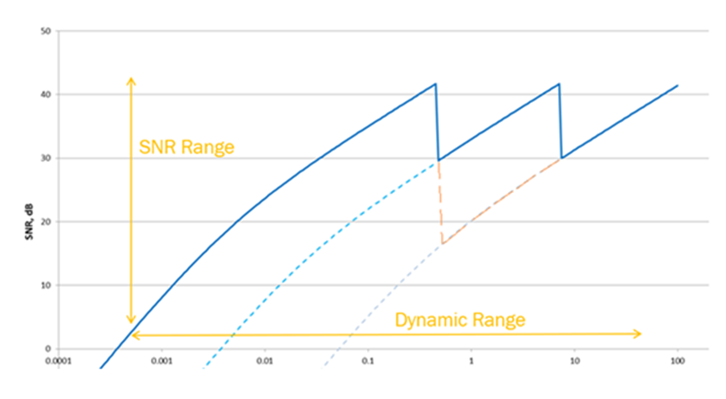
Figure 3 HDR image SNR

##Figure 4 SNR and Noise
The SNR of the automotive sensor is a non-monotone curve, and the automotive application environment will change the problem. More complex. The sensor is an analog device. Before the ADC, signal and noise data are stored in the form of charges. The dark current of the sensor will also accumulate charges. Its generation speed is roughly proportional to the exposure time and exponentially related to the temperature. So we must also consider the effects of temperature, exposure time, and analog gain on dark state noise. SNR is a function of temperature, exposure time and simulation gain at the same time, and its curve has become a multi-dimensional curve cluster.
Taking the influence of temperature as an example, Figure 5 is SNR=10The required Exposure value changes as the internal temperature of the sensor increases. We can see that different sensorThe sensitivity to temperature drift is different. The SNR exposure values of these two sensors cross at 60°C, which means that at room temperature 2# When ##5℃ and high temperature 80℃ were evaluated separately, the SNR conclusions reached were completely opposite.
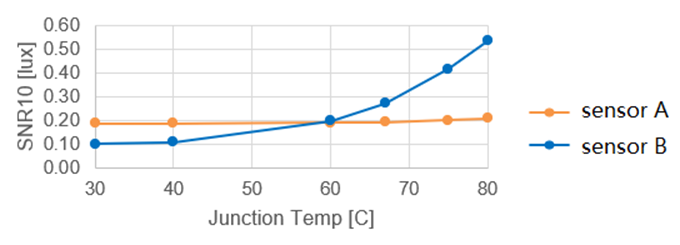 ##Figure
##Figure
5 Inside the wafer Temperature impact
According to the temperature distribution of the effective life cycle of the automotive camera, it exceeds 8# During the life cycle of ##8%, the temperature inside the sensor exceeds 40℃ and exceeds 80% The section temperature exceeds 60℃ within the time, and exceeds 65% The section temperature exceeds 8## within the time #0℃. The influence of temperature drift will cause further changes in the SNR curve. As shown by the red dotted line in Figure 6, when the temperature increases, the SNR curve will continue to decrease in low-illumination areas and highlighted local areas.
Figure
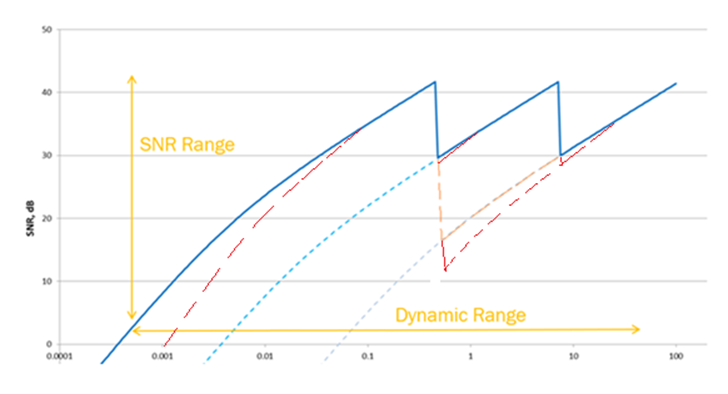 6
6
Temperature versus HDR SNR impact
Currently in the industry, the impact on automotive images The evaluation of sensor SNR is often tested using the European Machine Vision Association's EMVA1288 standard. The signal-to-noise ratio SNR in the EMVA1288 standard is defined based on the traditional monotonic linear sensor model, and the description of the SNR characteristics of the automotive wide dynamic image sensor is not complete. The Institute of Electrical and Electronics Engineers IEEE is defining a new quality test standard for automotive images P2020. As a member of the working group, ON Semiconductor has undertaken the IEEE The drafting of the image noise standard in the P2020 standard includes the SNR parameter.
Finally, to summarize, the signal-to-noise ratio SNR of the automotive CMOS image sensor is a key image quality indicator. It has non-monotonic characteristics and is affected by many factors in the automotive application environment. SNR evaluation is a multi-dimensional comprehensive evaluation task. Only objective and comprehensive SNR evaluation can truly describe the performance of the sensor and correctly guide the development of automotive imaging products.
The above is the detailed content of A brief discussion on automotive image sensor parameters - signal-to-noise ratio. For more information, please follow other related articles on the PHP Chinese website!

Hot AI Tools

Undresser.AI Undress
AI-powered app for creating realistic nude photos

AI Clothes Remover
Online AI tool for removing clothes from photos.

Undress AI Tool
Undress images for free

Clothoff.io
AI clothes remover

Video Face Swap
Swap faces in any video effortlessly with our completely free AI face swap tool!

Hot Article

Hot Tools

Notepad++7.3.1
Easy-to-use and free code editor

SublimeText3 Chinese version
Chinese version, very easy to use

Zend Studio 13.0.1
Powerful PHP integrated development environment

Dreamweaver CS6
Visual web development tools

SublimeText3 Mac version
God-level code editing software (SublimeText3)

Hot Topics
 1386
1386
 52
52
 Smart App Control on Windows 11: How to turn it on or off
Jun 06, 2023 pm 11:10 PM
Smart App Control on Windows 11: How to turn it on or off
Jun 06, 2023 pm 11:10 PM
Intelligent App Control is a very useful tool in Windows 11 that helps protect your PC from unauthorized apps that can damage your data, such as ransomware or spyware. This article explains what Smart App Control is, how it works, and how to turn it on or off in Windows 11. What is Smart App Control in Windows 11? Smart App Control (SAC) is a new security feature introduced in the Windows 1122H2 update. It works with Microsoft Defender or third-party antivirus software to block potentially unnecessary apps that can slow down your device, display unexpected ads, or perform other unexpected actions. Smart application
 The facial features are flying around, opening the mouth, staring, and raising eyebrows, AI can imitate them perfectly, making it impossible to prevent video scams
Dec 14, 2023 pm 11:30 PM
The facial features are flying around, opening the mouth, staring, and raising eyebrows, AI can imitate them perfectly, making it impossible to prevent video scams
Dec 14, 2023 pm 11:30 PM
With such a powerful AI imitation ability, it is really impossible to prevent it. It is completely impossible to prevent it. Has the development of AI reached this level now? Your front foot makes your facial features fly, and on your back foot, the exact same expression is reproduced. Staring, raising eyebrows, pouting, no matter how exaggerated the expression is, it is all imitated perfectly. Increase the difficulty, raise the eyebrows higher, open the eyes wider, and even the mouth shape is crooked, and the virtual character avatar can perfectly reproduce the expression. When you adjust the parameters on the left, the virtual avatar on the right will also change its movements accordingly to give a close-up of the mouth and eyes. The imitation cannot be said to be exactly the same, but the expression is exactly the same (far right). The research comes from institutions such as the Technical University of Munich, which proposes GaussianAvatars, which
 MotionLM: Language modeling technology for multi-agent motion prediction
Oct 13, 2023 pm 12:09 PM
MotionLM: Language modeling technology for multi-agent motion prediction
Oct 13, 2023 pm 12:09 PM
This article is reprinted with permission from the Autonomous Driving Heart public account. Please contact the source for reprinting. Original title: MotionLM: Multi-Agent Motion Forecasting as Language Modeling Paper link: https://arxiv.org/pdf/2309.16534.pdf Author affiliation: Waymo Conference: ICCV2023 Paper idea: For autonomous vehicle safety planning, reliably predict the future behavior of road agents is crucial. This study represents continuous trajectories as sequences of discrete motion tokens and treats multi-agent motion prediction as a language modeling task. The model we propose, MotionLM, has the following advantages: First
 Do you know that programmers will be in decline in a few years?
Nov 08, 2023 am 11:17 AM
Do you know that programmers will be in decline in a few years?
Nov 08, 2023 am 11:17 AM
"ComputerWorld" magazine once wrote an article saying that "programming will disappear by 1960" because IBM developed a new language FORTRAN, which allows engineers to write the mathematical formulas they need and then submit them. Give the computer a run, so programming ends. A few years later, we heard a new saying: any business person can use business terms to describe their problems and tell the computer what to do. Using this programming language called COBOL, companies no longer need programmers. . Later, it is said that IBM developed a new programming language called RPG that allows employees to fill in forms and generate reports, so most of the company's programming needs can be completed through it.
 GR-1 Fourier Intelligent Universal Humanoid Robot is about to start pre-sale!
Sep 27, 2023 pm 08:41 PM
GR-1 Fourier Intelligent Universal Humanoid Robot is about to start pre-sale!
Sep 27, 2023 pm 08:41 PM
The humanoid robot is 1.65 meters tall, weighs 55 kilograms, and has 44 degrees of freedom in its body. It can walk quickly, avoid obstacles quickly, climb steadily up and down slopes, and resist impact interference. You can now take it home! Fourier Intelligence's universal humanoid robot GR-1 has started pre-sale. Robot Lecture Hall Fourier Intelligence's Fourier GR-1 universal humanoid robot has now opened for pre-sale. GR-1 has a highly bionic trunk configuration and anthropomorphic motion control. The whole body has 44 degrees of freedom. It has the ability to walk, avoid obstacles, cross obstacles, go up and down slopes, resist interference, and adapt to different road surfaces. It is a general artificial intelligence system. Ideal carrier. Official website pre-sale page: www.fftai.cn/order#FourierGR-1# Fourier Intelligence needs to be rewritten.
 Huawei will launch the Xuanji sensing system in the field of smart wearables, which can assess the user's emotional state based on heart rate
Aug 29, 2024 pm 03:30 PM
Huawei will launch the Xuanji sensing system in the field of smart wearables, which can assess the user's emotional state based on heart rate
Aug 29, 2024 pm 03:30 PM
Recently, Huawei announced that it will launch a new smart wearable product equipped with Xuanji sensing system in September, which is expected to be Huawei's latest smart watch. This new product will integrate advanced emotional health monitoring functions. The Xuanji Perception System provides users with a comprehensive health assessment with its six characteristics - accuracy, comprehensiveness, speed, flexibility, openness and scalability. The system uses a super-sensing module and optimizes the multi-channel optical path architecture technology, which greatly improves the monitoring accuracy of basic indicators such as heart rate, blood oxygen and respiration rate. In addition, the Xuanji Sensing System has also expanded the research on emotional states based on heart rate data. It is not limited to physiological indicators, but can also evaluate the user's emotional state and stress level. It supports the monitoring of more than 60 sports health indicators, covering cardiovascular, respiratory, neurological, endocrine,
 What are the effective methods and common Base methods for pedestrian trajectory prediction? Top conference papers sharing!
Oct 17, 2023 am 11:13 AM
What are the effective methods and common Base methods for pedestrian trajectory prediction? Top conference papers sharing!
Oct 17, 2023 am 11:13 AM
Trajectory prediction has been gaining momentum in the past two years, but most of it focuses on the direction of vehicle trajectory prediction. Today, Autonomous Driving Heart will share with you the algorithm for pedestrian trajectory prediction on NeurIPS - SHENet. In restricted scenes, human movement patterns are usually To a certain extent, it conforms to limited rules. Based on this assumption, SHENet predicts a person's future trajectory by learning implicit scene rules. The article has been authorized to be original by Autonomous Driving Heart! The author's personal understanding is that currently predicting a person's future trajectory is still a challenging problem due to the randomness and subjectivity of human movement. However, human movement patterns in constrained scenes often vary due to scene constraints (such as floor plans, roads, and obstacles) and human-to-human or human-to-object interactivity.
 Read the smart car skateboard chassis in one article
May 24, 2023 pm 12:01 PM
Read the smart car skateboard chassis in one article
May 24, 2023 pm 12:01 PM
01 What is a skateboard chassis? The so-called skateboard chassis integrates the battery, electric transmission system, suspension, brakes and other components on the chassis in advance to achieve separation of the body and chassis and decoupling the design. Based on this type of platform, car companies can significantly reduce early R&D and testing costs, while quickly responding to market demand to create different models. Especially in the era of driverless driving, the layout of the car is no longer centered on driving, but will focus on space attributes. The skateboard-type chassis can provide more possibilities for the development of the upper cabin. As shown in the picture above, of course when we look at the skateboard chassis, we should not be framed by the first impression of "Oh, it is a non-load-bearing body" when we come up. There were no electric cars back then, so there were no battery packs worth hundreds of kilograms, no steering-by-wire system that could eliminate the steering column, and no brake-by-wire system.



